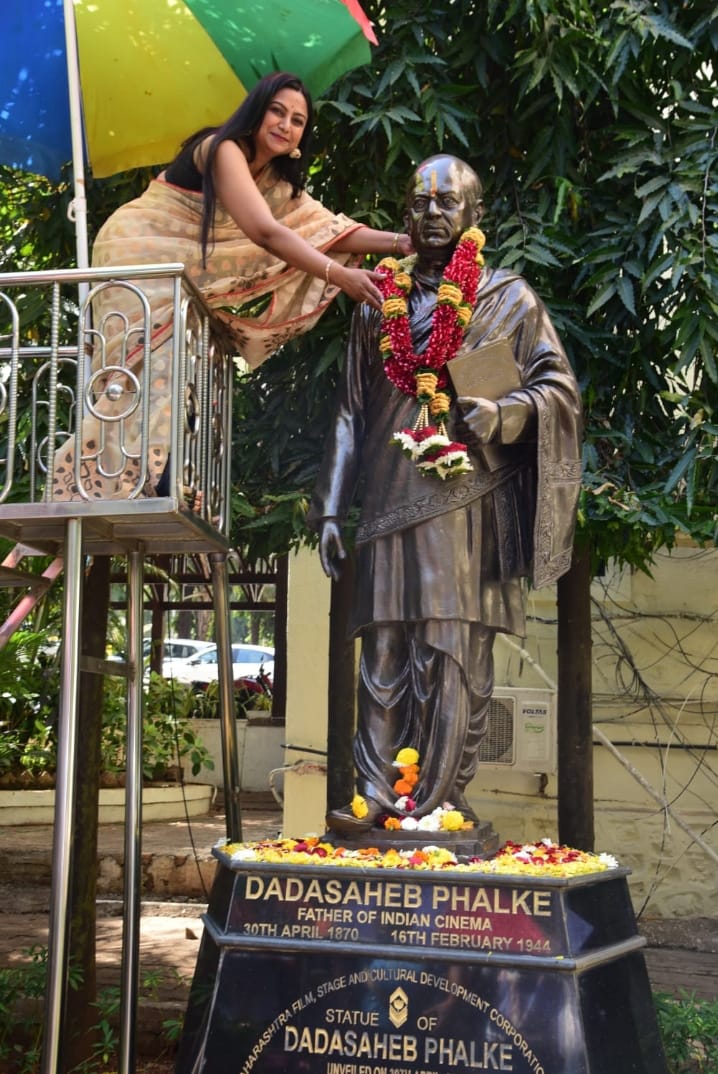
Presentation: Kali Das Pandey
Mumbai’s Goregaon-based Dadasaheb Phalke Chitranagari, Film City Studio, witnessed a grand ceremony on the occasion of the 81st death anniversary of the Father of Indian Cinema, Dadasaheb Phalke. The event was organized by the Film City Studio management, where Phalke’s grandson Chandrashekhar Pusalkar, along with his wife Mridula Pusalkar and adopted daughter Neha Bandopadhyay, marked their presence. Representatives from Indian film industry organizations, renowned Bollywood personalities, Maharashtra government officials, and attendees from various states of India paid floral tributes to the statue of Dadasaheb Phalke and honored his legacy.
Dadasaheb Phalke, the founder of Indian cinema, directed 121 films in his 19-year-long career, including 26 short films. He was not just a director but also a renowned producer and screenwriter. His last silent film was Setubandhan, while Gangavataran was his final feature film. He passed away on February 16, 1944, in Nashik. In his honor, the Government of India introduced the Dadasaheb Phalke Award in 1969, the most prestigious award in Indian cinema. The first recipient of this award was Devika Rani Chaudhary. In 1971, the Indian Postal Department also issued a commemorative stamp in his honor.
Born as Dhundiraj Phalke on April 30, 1870, in Trimbak, Bombay Presidency, Phalke belonged to a Marathi family. His father, Govind Sadashiv Phalke, was a Sanskrit scholar and Hindu priest, while his mother, Dwarkabai, was a homemaker. He completed his primary schooling in Trimbakeshwar and matriculation in Bombay. In 1885, he completed a one-year drawing course from Sir J. J. School of Arts, Bombay, and later pursued painting and watercolor techniques at Maharaja Sayajirao University’s Kala Bhavan in Baroda. He also developed skills in architecture and modeling. In the same year, he purchased a film camera and began experimenting with photography, printing, and processing.
After gaining permission to use the equipment at Kala Bhavan, Phalke established a photo studio named Shri Phalke Engraving and Photo Printing. Initially facing setbacks, he later worked in theatre production, securing small acting roles. He also served as a photographer for the Archaeological Survey of India. In 1912, he set up a small glass studio for film shooting and a darkroom for film processing. After overcoming numerous challenges, he created India’s first feature film, Raja Harishchandra, which premiered at Olympia Theatre in Bombay. The film performed exceptionally well at the box office and laid the foundation of the Indian film industry.
During British rule, Western films were being screened in India, but Phalke chose to use mythology as a tool to connect Indians with their cultural roots. However, at the time of Raja Harishchandra, it was considered inappropriate for women to act in films. As a result, the role of Queen Taramati was played by a male actor, Anna Salunke. Determined to change this, Phalke cast Durgabai Kamat as Goddess Parvati and her daughter Kamalabai Gokhale as Mohini in Mohini Bhasmasur (1913), making them the first female actors in Indian cinema. Facing social rejection, Kamat nevertheless paved the way for women to take on leading roles in films. Later, Phalke cast his daughter Mandakini Phalke in Lanka Dahan (1917) and Shri Krishna Janma (1918). His wife, Saraswatibai Phalke, also played a crucial role in Indian cinema, becoming India’s first female film editor and contributing to films like Raja Harishchandra.
Today, the Indian film industry is a billion-dollar enterprise employing millions of people. Yet, Dadasaheb Phalke laid its foundation with an investment of merely ₹20,000-25,000. Though he is no longer among us, his legacy continues to inspire filmmakers and artists, reminding them of perseverance and dedication to their craft. His contributions to Indian cinema will be remembered for generations to come.